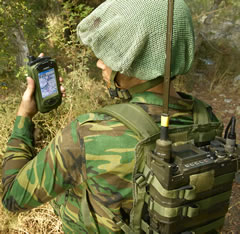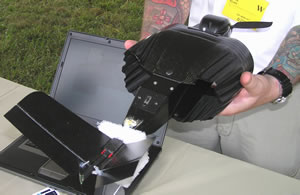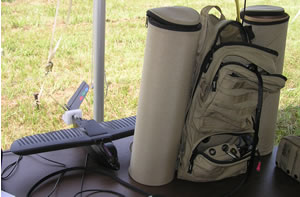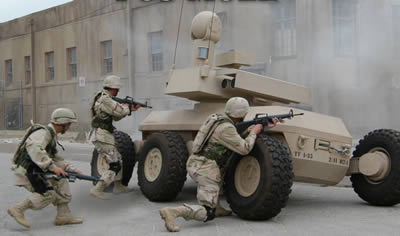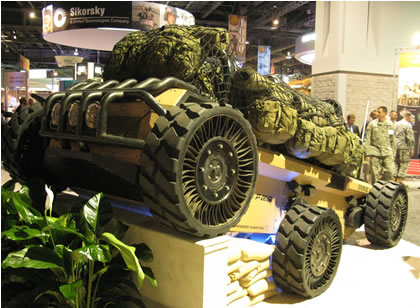Improvised Explosive Devices (IEDs) continue to pose a challenge to coalition forces in Iraq and Afghanistan. Some of the best minds in the defense industry are searching for effective countermeasures against these threats, some were introduced at AUSA 2007. Among these were systems enabling the engagement of IEDs from stand-off distance, shooting them with machine guns or frying them with lasers; A new jammer that can better cope with the illusive radio or phone triggered devices and a low-cost robot designed to blast the IEDs with a big bang, before they are activated by the enemy.
Gyrocam has already received orders for several hundreds of systems from the USMC, Army and Navy. The company demonstrated its multi-sensor mast-mounted EO system associated with a remote weapon station proposed as an IED hunter killer. This concept seems to attract much interest with US forces in Iraq, as it provides more flexibility within standard operational practices, enabling troops to maintain significant stand-off distance while spotting, detecting and engaging suspected objects, without entering a potential kill-zone, set by hostile elements near an IED ambush site. Such flexible procedures are also less susceptible to exploitation by the enemy. Gyrocam has been contracted to supply several hundred multi-sensor mast-mounted electro-optical payloads to be used for force protection applications. The company demonstrated the integration of such payload with BAE System’s Lemur remotely operated weapon station, used as a Counter IED system.
A different method of defeating an IED from stand-off distance is proposed by Boeing, utilizing the company’s latest addition to the Avenger Agile Multi-Role Weapon System (AMWS) very short-range air defense (VSHORAD) system. Boeing recently demonstrated how energetic materials can be neutralized by laser beams from safe distance. The Laser Avenger was employed in such a demonstration on September 26-27, 2007 at the US Army Redstone Arsenal in Huntsville, Ala. The vehicle was equipped with a 1-kilowatt solid-state laser. The laser segment of Laser Avenger will have uses beyond the counter-IED, counter-UXO mission. For example, it could be upgraded to have a shoot-on-the-move capability and to blind or destroy other kinds of targets, including low-flying unmanned aerial vehicles. The laser was  added while retaining Avenger’s ability to carry other weapons, including missiles and a machine gun. Boeing plans to offer AMWS and Laser Avenger as product improvements for over 600 Avengers are deployed with military users worldwide.
added while retaining Avenger’s ability to carry other weapons, including missiles and a machine gun. Boeing plans to offer AMWS and Laser Avenger as product improvements for over 600 Avengers are deployed with military users worldwide.
Elbit Systems unveiled its latest electronic countermeasure designed to combat Remotely-Controlled Improvised Explosive Devices (RCIED). The new IED Jammer (IEDJ) represents Elbit Systems’ latest generation system, earlier countermeasures developed by Elbit and its subsidiaries have been combat proven in different war zones worldwide. The new vehicle-mounted system is designed as a modular, programmable multi-band radio-frequency jammer which denies enemy use of selected portions of the RF spectrum in the system’s vicinity. Unlike earlier generation devices using broadband ‘barrage’ to block entire wavelengths associated with suspected RCIED triggering devices (which usually cover most of the frequencies used by radio communications and cellular phones), Elbit’s IEDJ uses specific waveforms, rather than barrage jamming. Barrage can be programmed into the hardware, where required. The system can transmit on all bands simultaneously, effectively countering a wide range of potential threats.
 AMTI, a SAIC subsidiary developed the Seeker family of small robots, designed for detection and defeat of IED threats. SAIC offers two Seeker series robots – the R500E, and R421. The R-500E, weighing about 30 pounds, designed for multi-use, is applied as a low-cost device, priced for mass distribution to EOD units and other commands. Employed as a forward scout, about 1,000 feet in front of the troops, the R-500E can search for suspicious objects and identify potential IEDs by ‘sniffing’ them explosive detection sensors. If an IED is detected, R-500E or its smaller ‘brother’, R-421 can deploy an explosive charge and clear the area before the detonation. The robot carries such charges on a trailer, carrying a weight of up to 25 pounds (15 punds with the R-412). R-500E is equipped with two forward looking cameras and pan-tilt camera for recon. A microphone is also used to send back information. For night operation the robot uses an Infrared LED array.
AMTI, a SAIC subsidiary developed the Seeker family of small robots, designed for detection and defeat of IED threats. SAIC offers two Seeker series robots – the R500E, and R421. The R-500E, weighing about 30 pounds, designed for multi-use, is applied as a low-cost device, priced for mass distribution to EOD units and other commands. Employed as a forward scout, about 1,000 feet in front of the troops, the R-500E can search for suspicious objects and identify potential IEDs by ‘sniffing’ them explosive detection sensors. If an IED is detected, R-500E or its smaller ‘brother’, R-421 can deploy an explosive charge and clear the area before the detonation. The robot carries such charges on a trailer, carrying a weight of up to 25 pounds (15 punds with the R-412). R-500E is equipped with two forward looking cameras and pan-tilt camera for recon. A microphone is also used to send back information. For night operation the robot uses an Infrared LED array.

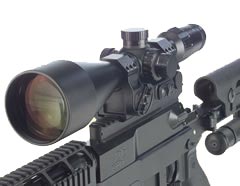
 Several systems are currently under development by US-Israeli and DARPA initiatives. A joint US-Israeli development, under Israel’s Defense Research & Development Directorate (DRDD) management currently under development at ITL, utilizes a cross-wind laser measurement concept, developed by Dr Joseph Shapira from Soreq Nuclear Research Center. This is evaluating fire control systems designed to improve the sniper team’s performance. ITL unveiled a model of this system, dubbed ‘Focus’, designed as a fire control system to be operated by the sniper team spotter, supporting up to eight sniper positions simultaneously. The system employs a laser beam that instantly measures and profiles wind-flow, creating a three-dimensional model used in the ballistic calculation. Focus will provide each sniper with individual ballistic correction, based on accurate measurements of cross-wind downrange, temperature, range and inclination.
Several systems are currently under development by US-Israeli and DARPA initiatives. A joint US-Israeli development, under Israel’s Defense Research & Development Directorate (DRDD) management currently under development at ITL, utilizes a cross-wind laser measurement concept, developed by Dr Joseph Shapira from Soreq Nuclear Research Center. This is evaluating fire control systems designed to improve the sniper team’s performance. ITL unveiled a model of this system, dubbed ‘Focus’, designed as a fire control system to be operated by the sniper team spotter, supporting up to eight sniper positions simultaneously. The system employs a laser beam that instantly measures and profiles wind-flow, creating a three-dimensional model used in the ballistic calculation. Focus will provide each sniper with individual ballistic correction, based on accurate measurements of cross-wind downrange, temperature, range and inclination. Another device called Sniper Auxiliary Attachment Module (SAM), designed for the sniper team, was unveiled by Carl Zeiss Optronics. SAM fits 6-24×72 telescopic sights enabling marksmen to receive critical information without taking their eyes off the target. SAM has been developed to solve the problem which marksmen have in preparing the rifle while still observing, identifying and targeting a threat. At a touch of a button, users receive menu-guided information on current settings enabling them to easily determine the current position of elevation and azimuth turret settings at night, plus information indicating temperature and air pressure. Data on the weapon-tilt angle and the slant error is also displayed in the user’s field of view. When added with wind direction and speed, this information is used to calculate a ballistic solution. For spotters, the new Spotter 60 provides fatigue-free observation, clarification and precise acquisition of targets at greater distances and over extended time periods . It has a variable magnification range of 20 – 60 power, an optical clear objective diameter of 72 mm and a focus range of 20m to infinity. Spotter 60 uses a MIL-DOT aiming-point sight, which reduces the difficulty in finding a target, usually experienced with such high magnification devices.
Another device called Sniper Auxiliary Attachment Module (SAM), designed for the sniper team, was unveiled by Carl Zeiss Optronics. SAM fits 6-24×72 telescopic sights enabling marksmen to receive critical information without taking their eyes off the target. SAM has been developed to solve the problem which marksmen have in preparing the rifle while still observing, identifying and targeting a threat. At a touch of a button, users receive menu-guided information on current settings enabling them to easily determine the current position of elevation and azimuth turret settings at night, plus information indicating temperature and air pressure. Data on the weapon-tilt angle and the slant error is also displayed in the user’s field of view. When added with wind direction and speed, this information is used to calculate a ballistic solution. For spotters, the new Spotter 60 provides fatigue-free observation, clarification and precise acquisition of targets at greater distances and over extended time periods . It has a variable magnification range of 20 – 60 power, an optical clear objective diameter of 72 mm and a focus range of 20m to infinity. Spotter 60 uses a MIL-DOT aiming-point sight, which reduces the difficulty in finding a target, usually experienced with such high magnification devices.
 The missile is designed to engage missile and rocket threats with ranges of 70 – 200 km. The new system will establish a lower tier below the IAI Arrow 2 missile, which extends the defensive capability to longer range and higher altitude. Known as ‘Magic Wand’ this program will be managed by the Israel Missile Defense Organization (IMDO), which already supervises Israel’s ballistic missile defense program.
The missile is designed to engage missile and rocket threats with ranges of 70 – 200 km. The new system will establish a lower tier below the IAI Arrow 2 missile, which extends the defensive capability to longer range and higher altitude. Known as ‘Magic Wand’ this program will be managed by the Israel Missile Defense Organization (IMDO), which already supervises Israel’s ballistic missile defense program. A different weapon system from Raytheon addresses close-in protection against asymmetric threats, using the Laser Area Defense System (LADS). Raytheon is developing this capability to expand the defended footprint and complement kinetic energy system capabilities (such as the Centurion CIWS). The system will also provide effective response against unmanned systems and sensors and could augment ship defense with effective countermeasures against floating mines and multiple small explosive boats. The LADS’ effector uses a beam director replacing the 20mm Phalanx gun. The beam director is linked to a commercially available 20kilowatt fiber-laser produced by IPG Photonics. The system is powered by a diesel generator. During the system demonstration phase conducted in 2006, LADS destroyed static 60mm mortar bombs at a range of more than 550 meters.
A different weapon system from Raytheon addresses close-in protection against asymmetric threats, using the Laser Area Defense System (LADS). Raytheon is developing this capability to expand the defended footprint and complement kinetic energy system capabilities (such as the Centurion CIWS). The system will also provide effective response against unmanned systems and sensors and could augment ship defense with effective countermeasures against floating mines and multiple small explosive boats. The LADS’ effector uses a beam director replacing the 20mm Phalanx gun. The beam director is linked to a commercially available 20kilowatt fiber-laser produced by IPG Photonics. The system is powered by a diesel generator. During the system demonstration phase conducted in 2006, LADS destroyed static 60mm mortar bombs at a range of more than 550 meters.
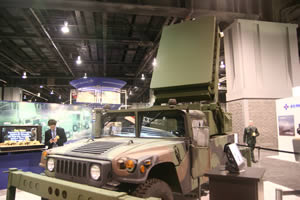
 Modern armies, particularly the US and British armies are reevaluating the role of the light mortar, recognizing its contribution to provide close, accurate and self-sustained support at company and battalion level. These small caliber weapons, including 60, 81 and 120mm tubes offer mechanized and dismounted units effective, accurate firepower capable of hitting targets at ‘non-line of sight’ engagement, particularly in urban, mountainous and densely vegetated areas, including jungle or forest. Self propelled mortars operated by the US Army in the Stryker brigades are operated as a self-propelled fire bases, fielding 120, 81 and 60 mm tubes. The British Army is also considering using this concept with its FRES IFS mortar carrier variant, which will include a 60mm and 81mm tubes, with a growth option to 120mm.
Modern armies, particularly the US and British armies are reevaluating the role of the light mortar, recognizing its contribution to provide close, accurate and self-sustained support at company and battalion level. These small caliber weapons, including 60, 81 and 120mm tubes offer mechanized and dismounted units effective, accurate firepower capable of hitting targets at ‘non-line of sight’ engagement, particularly in urban, mountainous and densely vegetated areas, including jungle or forest. Self propelled mortars operated by the US Army in the Stryker brigades are operated as a self-propelled fire bases, fielding 120, 81 and 60 mm tubes. The British Army is also considering using this concept with its FRES IFS mortar carrier variant, which will include a 60mm and 81mm tubes, with a growth option to 120mm. As one of the innovators in this field, Israel’s mortar expert Soltam Systems introduced a new, lightweight C-06 60mm mortar system offering 20% weight reduction by utilizing forged aluminum base plate, lightweight bipod and highly efficient tube, capable of firing mortar bombs with M-38A1 proximity fuzes, dramatically increasing the lethality of the weapon against unprotected targets, while minimizing collateral damage by using smaller caliber bombs. In fact, a two man firing team can rapidly generate continuous fire for effect within very short time, in direct support of their units. Mortars are usually operated manually at targets visible by a fire director or the firing team. Firing at high precision at a specific GPS location can achieved within less than 30 seconds with this weapon, using Soltam’s hand-held fire control computer, which supports the entire range of tubes, including 120, 81 and 60mm.
As one of the innovators in this field, Israel’s mortar expert Soltam Systems introduced a new, lightweight C-06 60mm mortar system offering 20% weight reduction by utilizing forged aluminum base plate, lightweight bipod and highly efficient tube, capable of firing mortar bombs with M-38A1 proximity fuzes, dramatically increasing the lethality of the weapon against unprotected targets, while minimizing collateral damage by using smaller caliber bombs. In fact, a two man firing team can rapidly generate continuous fire for effect within very short time, in direct support of their units. Mortars are usually operated manually at targets visible by a fire director or the firing team. Firing at high precision at a specific GPS location can achieved within less than 30 seconds with this weapon, using Soltam’s hand-held fire control computer, which supports the entire range of tubes, including 120, 81 and 60mm. DARPA and BAE Systems have more ambitious plans for the 60 mm mortar. At AUSA 2007 BAE Systems displayed the latest model of the Optically Directed Advanced Munition (ODAM), developed under a $9 million program awarded in 2005 by darpa. Under this initiative, BAE Systems is planning to demonstrate a laser-guided, low cost optical seeker for the 60mm mortar. The guidance kit will be designed to replace the current 60mm mortar fuse to improve firing precision. Additionally, research will be done with explosives to improve the effectiveness of 60mm explosive rounds. Accroding to DARPA, the goal is to develop a 60mm projectile with the effectiveness of a 105mm high explosive projectile. If fielded, such systems could improve the effectiveness of small dismounted units, employing precision indirect munitions that can operate across multiple environments, including urban and mountaneous terrain.
DARPA and BAE Systems have more ambitious plans for the 60 mm mortar. At AUSA 2007 BAE Systems displayed the latest model of the Optically Directed Advanced Munition (ODAM), developed under a $9 million program awarded in 2005 by darpa. Under this initiative, BAE Systems is planning to demonstrate a laser-guided, low cost optical seeker for the 60mm mortar. The guidance kit will be designed to replace the current 60mm mortar fuse to improve firing precision. Additionally, research will be done with explosives to improve the effectiveness of 60mm explosive rounds. Accroding to DARPA, the goal is to develop a 60mm projectile with the effectiveness of a 105mm high explosive projectile. If fielded, such systems could improve the effectiveness of small dismounted units, employing precision indirect munitions that can operate across multiple environments, including urban and mountaneous terrain.
 The sectarian bloodshed in Iraq, between Arab Shiites and Sunnis, all have the signs of a hegemonic Persian ambition. No one in Iraq exemplifies this better than Moqtada Al Sadr, the leader of its largest Shia militia — the “Mahdi Army” to which the Iranian government is behind shipping components used to make improvised explosive devices for Iraqi insurgents, fighting both US forces and Sunni militias.
The sectarian bloodshed in Iraq, between Arab Shiites and Sunnis, all have the signs of a hegemonic Persian ambition. No one in Iraq exemplifies this better than Moqtada Al Sadr, the leader of its largest Shia militia — the “Mahdi Army” to which the Iranian government is behind shipping components used to make improvised explosive devices for Iraqi insurgents, fighting both US forces and Sunni militias. The White House made the announcement last Friday in Washington, claiming that the aggressive new policy is a direct response to intelligence reports, that Iran is supporting terrorists inside Iraq and is providing sophisticated improvised explosive devices (IED) – and other equipment to anti-American. insurgents. On January 10, President Bush accused Iran and Syria of allowing terrorists and insurgents to use their territory to move in and out of Iraq. He warned that US troops would take measures, including seeking out and destroying ” the networks providing advanced weaponry and training to our enemies in Iraq.” According to new orders, US troops in Iraq now have full authority to kill or capture Iranian agents deemed to be a threat. AS result, five Iranians were detained by U.S.-led forces earlier this month after a commando raid on an Iranian government liaison office in northern Iraq. According to Associated Press news agency, the administration said at the time that U.S. forces entered an Iranian building in Kurdish-controlled Irbil because information linked it to Revolutionary Guards and other Iranian elements engaging in violent activities in Iraq.
The White House made the announcement last Friday in Washington, claiming that the aggressive new policy is a direct response to intelligence reports, that Iran is supporting terrorists inside Iraq and is providing sophisticated improvised explosive devices (IED) – and other equipment to anti-American. insurgents. On January 10, President Bush accused Iran and Syria of allowing terrorists and insurgents to use their territory to move in and out of Iraq. He warned that US troops would take measures, including seeking out and destroying ” the networks providing advanced weaponry and training to our enemies in Iraq.” According to new orders, US troops in Iraq now have full authority to kill or capture Iranian agents deemed to be a threat. AS result, five Iranians were detained by U.S.-led forces earlier this month after a commando raid on an Iranian government liaison office in northern Iraq. According to Associated Press news agency, the administration said at the time that U.S. forces entered an Iranian building in Kurdish-controlled Irbil because information linked it to Revolutionary Guards and other Iranian elements engaging in violent activities in Iraq. As if the internecine Hamas Fatah fighting in the Gaza Strip seemed to have stopped suicide attacks on Israel for a while, the bloody attack by an Islamic Jihad bomber, identified as Mohamed Faisal al-Sahsah, 21 from Gaza, indicated that Iran would not let this temporary lull to continue. Military sources disclosed, that the fingerprints of the newly appointed Jihad Islami leader of Palestinian Jihad Islami terrorist ace Muhamed al Hindi were clearly distinct on Monday’s Eilat suicide bombing. Al Hindi returned to the Gaza Strip on January 19 after a six-month absence in Damascus, Beirut and Tehran, during which his Syrian and Iranian masters appointed him chief of the operations. His former boss, Abdallah Ramadan Shelah, who seemed to have lost some favor to his Tehran masters, was a key member of the Palestine delegation, which held recent talks in Damascus last week, presided by Ali Larijani, the secretary general of Iran’s Supreme National Security Council (SNSC).
As if the internecine Hamas Fatah fighting in the Gaza Strip seemed to have stopped suicide attacks on Israel for a while, the bloody attack by an Islamic Jihad bomber, identified as Mohamed Faisal al-Sahsah, 21 from Gaza, indicated that Iran would not let this temporary lull to continue. Military sources disclosed, that the fingerprints of the newly appointed Jihad Islami leader of Palestinian Jihad Islami terrorist ace Muhamed al Hindi were clearly distinct on Monday’s Eilat suicide bombing. Al Hindi returned to the Gaza Strip on January 19 after a six-month absence in Damascus, Beirut and Tehran, during which his Syrian and Iranian masters appointed him chief of the operations. His former boss, Abdallah Ramadan Shelah, who seemed to have lost some favor to his Tehran masters, was a key member of the Palestine delegation, which held recent talks in Damascus last week, presided by Ali Larijani, the secretary general of Iran’s Supreme National Security Council (SNSC).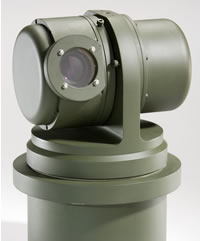
 BAE Systems demonstrated its Watch-6 vehicle perimeter peripheral surveillance system, effectively covering the vehicle’s surroundingfrom positions at the four corners of the vehicle. The sensor includes uncooled thermal and video cameras, for day and night surveillanceunder all visibility conditions. Check-6, a camera integrated into teh vehicle’s headlights and tail lights.
BAE Systems demonstrated its Watch-6 vehicle perimeter peripheral surveillance system, effectively covering the vehicle’s surroundingfrom positions at the four corners of the vehicle. The sensor includes uncooled thermal and video cameras, for day and night surveillanceunder all visibility conditions. Check-6, a camera integrated into teh vehicle’s headlights and tail lights. A different concept of a panoramic vision system was demonstrated by Elbit Systems, introducing the ‘See Through Armor’ (STA), a panoramic observation system which can be embedded into new armor, or installed as ‘add-on’ to existing vehicles, providing the vehicle crews with an omni-directional combat scene seen from within the armored vehicle, when the crew is ‘buttoned in’ with hatches closed. An equally realistic view can be obtained from an unmanned platform. The objective of the system is to improve the crew’s situational awareness under all conditions, including extended ‘silent watch’ missions in areas where close-quarter defense is imperative (including urban areas, jungle etc), where the techniques, tactics and procedures (TTP) dictate maximum force protection with the crew remaining ‘buttoned up’ inside their vehicles for hours. Under such conditions, limited visibility creates ‘dead zones’ attracting attack by hostiles, exploiting the limited visibility by the crew, to hit the vehicle with RPGs or lay down belly-striking explosive charges activated from a distance.
A different concept of a panoramic vision system was demonstrated by Elbit Systems, introducing the ‘See Through Armor’ (STA), a panoramic observation system which can be embedded into new armor, or installed as ‘add-on’ to existing vehicles, providing the vehicle crews with an omni-directional combat scene seen from within the armored vehicle, when the crew is ‘buttoned in’ with hatches closed. An equally realistic view can be obtained from an unmanned platform. The objective of the system is to improve the crew’s situational awareness under all conditions, including extended ‘silent watch’ missions in areas where close-quarter defense is imperative (including urban areas, jungle etc), where the techniques, tactics and procedures (TTP) dictate maximum force protection with the crew remaining ‘buttoned up’ inside their vehicles for hours. Under such conditions, limited visibility creates ‘dead zones’ attracting attack by hostiles, exploiting the limited visibility by the crew, to hit the vehicle with RPGs or lay down belly-striking explosive charges activated from a distance. A complimentary sensor that can be applied to panoramic vision is the
A complimentary sensor that can be applied to panoramic vision is the  camera, thermal camera and laser rangefinder, enabling target engagement under day and night conditions. The system features programmable target reference points for multiple locations, programmable sector surveillance scanning and setting of multiple, restricted no-fire zones. The optronic system enables the gunner to view the target independent of gun elevation. Other features include auto- tracking; auto-lead and auto-scan functions.
camera, thermal camera and laser rangefinder, enabling target engagement under day and night conditions. The system features programmable target reference points for multiple locations, programmable sector surveillance scanning and setting of multiple, restricted no-fire zones. The optronic system enables the gunner to view the target independent of gun elevation. Other features include auto- tracking; auto-lead and auto-scan functions. (unloaded, unarmored) and protrudes 28″ above deck. The system can be folded to reduce height by 10″ on transit.
(unloaded, unarmored) and protrudes 28″ above deck. The system can be folded to reduce height by 10″ on transit. and ammunition. Lightning is fitted with day and night optics. Also evaluated are the integration of CROWS-Lightning and the PD Cue 4 corner acoustic gunshot detection system, offering complete threat detection and engagement capability. Two additional lightweight weapon stations at AUSA were Rafael’s Samson Junior and Elbit Systems
and ammunition. Lightning is fitted with day and night optics. Also evaluated are the integration of CROWS-Lightning and the PD Cue 4 corner acoustic gunshot detection system, offering complete threat detection and engagement capability. Two additional lightweight weapon stations at AUSA were Rafael’s Samson Junior and Elbit Systems 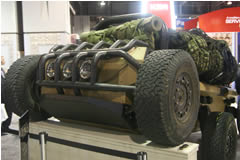
 EM1 examined initial FCS system designs, functional and performance analyses, software and hardware maturation, Spin Out 1 deliveries, and progress in experimentation and testing since the Initial Preliminary Design Review in August 2006. Final design concepts will be presented during individual system-level Preliminary Design Reviews over the next year and later assessed during the System-of-Systems Preliminary Design Review in early 2009 to confirm they can proceed to final detail design and testing.
EM1 examined initial FCS system designs, functional and performance analyses, software and hardware maturation, Spin Out 1 deliveries, and progress in experimentation and testing since the Initial Preliminary Design Review in August 2006. Final design concepts will be presented during individual system-level Preliminary Design Reviews over the next year and later assessed during the System-of-Systems Preliminary Design Review in early 2009 to confirm they can proceed to final detail design and testing. The Battle Command and SOSCOE software enables interoperability between systems, prioritizing raw data from sensors such as the Tactical- and
The Battle Command and SOSCOE software enables interoperability between systems, prioritizing raw data from sensors such as the Tactical- and  Among the systems on display at AUSA 07 were parts of the FCS active protection system, developed for the ground vehicle systems (MGS). the system elements on display included – Left: Multifunction Radar Frequency sensor (MFRF), center: Common RF electronics unit (CREU), Back: Mast Mounted Sensor including a Medium range EO (MREO) and Combat ID System and the Transponder Antenna Subsystem (TAS), right: Interrogator Antenna Subsystem (IAS) and Common Electronics Interface unit (CEIU).
Among the systems on display at AUSA 07 were parts of the FCS active protection system, developed for the ground vehicle systems (MGS). the system elements on display included – Left: Multifunction Radar Frequency sensor (MFRF), center: Common RF electronics unit (CREU), Back: Mast Mounted Sensor including a Medium range EO (MREO) and Combat ID System and the Transponder Antenna Subsystem (TAS), right: Interrogator Antenna Subsystem (IAS) and Common Electronics Interface unit (CEIU).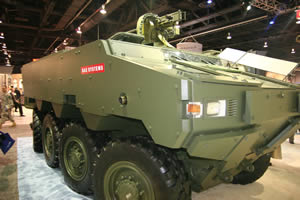

 Addressing the growing demand for on-board power, a new 500 Amp alternator will be installed, coupled with an expandable and scalable solid-state power distribution and control system. An optional Lithium-ion battery pack could nearly double electrical power storage capacity on board, with the same space claim as the standard vehicle battery pack. The crew will be able to exhaust nearly all battery power without having engine restart failures, relying on the 24V Capacitive Start System offering power reserve for the engine starter, independent of the main battery. The vehicle was demonstrated at AUSA 2007 with a Protector Weapon station mounting a heavy machine gun and a Javelin missile launcher.
Addressing the growing demand for on-board power, a new 500 Amp alternator will be installed, coupled with an expandable and scalable solid-state power distribution and control system. An optional Lithium-ion battery pack could nearly double electrical power storage capacity on board, with the same space claim as the standard vehicle battery pack. The crew will be able to exhaust nearly all battery power without having engine restart failures, relying on the 24V Capacitive Start System offering power reserve for the engine starter, independent of the main battery. The vehicle was demonstrated at AUSA 2007 with a Protector Weapon station mounting a heavy machine gun and a Javelin missile launcher. BAE Systems Hagglunds introduced their SEP 8×8 vehicle at AUSA 2007. This platform is a larger version of the wheeled SEP 6×6 developed as the ‘next generation military vehicle system’ program funded by the Swedish Defence Materiel Administration (FMV). According to BAE Hagglunds plans, SEP 8×8 could be available for delivery by 2011. SEP is built on a modular platform, enabling growth potential and adaptation to a wide range of applications. Unlike the 6×6 version, SEP 8×8 uses mechanical transmission, designed to meet FRES requirements. Other SEP family vehicles use electronic transmission. SEP 8×8 was configured as a wheeled armored vehicle with a full combat weight of 24 – 27 tons (curb weight in an APC version is 14.5 tons). This version was originally designed by BAE Systems Hagglunds, competing with the Piranha V, Boxer and VBCI for the British FRES program, but eventually dropped after trials.
BAE Systems Hagglunds introduced their SEP 8×8 vehicle at AUSA 2007. This platform is a larger version of the wheeled SEP 6×6 developed as the ‘next generation military vehicle system’ program funded by the Swedish Defence Materiel Administration (FMV). According to BAE Hagglunds plans, SEP 8×8 could be available for delivery by 2011. SEP is built on a modular platform, enabling growth potential and adaptation to a wide range of applications. Unlike the 6×6 version, SEP 8×8 uses mechanical transmission, designed to meet FRES requirements. Other SEP family vehicles use electronic transmission. SEP 8×8 was configured as a wheeled armored vehicle with a full combat weight of 24 – 27 tons (curb weight in an APC version is 14.5 tons). This version was originally designed by BAE Systems Hagglunds, competing with the Piranha V, Boxer and VBCI for the British FRES program, but eventually dropped after trials. BAE Systems displayed its new aluminum-based L-ROD bar armor at AUSA, shown on an RG-33 vehicle. The company was recently awarded a $15.5 million contract to provide these lightweight bar-armor kits for 215 Route Clearance Vehicles operated by the U.S. Army. Under the contract from the Army’s Tank-automotive Armaments Command, BAE Systems will equip RG31 and Cougar vehicles with its L-ROD aluminum armor, used widely on Army Buffalo ordnance disposal vehicles. L-ROD is standard equipment on the Army Buffalo explosive ordnance disposal vehicle. BAE Systems has delivered more than 100 L-ROD kits to the Army, with additional kits slated for the Marine Corps’ Buffalo vehicles. The company also is completing L-ROD designs for BAE Systems’ Caiman II and RG33-series mine-protected vehicles.
BAE Systems displayed its new aluminum-based L-ROD bar armor at AUSA, shown on an RG-33 vehicle. The company was recently awarded a $15.5 million contract to provide these lightweight bar-armor kits for 215 Route Clearance Vehicles operated by the U.S. Army. Under the contract from the Army’s Tank-automotive Armaments Command, BAE Systems will equip RG31 and Cougar vehicles with its L-ROD aluminum armor, used widely on Army Buffalo ordnance disposal vehicles. L-ROD is standard equipment on the Army Buffalo explosive ordnance disposal vehicle. BAE Systems has delivered more than 100 L-ROD kits to the Army, with additional kits slated for the Marine Corps’ Buffalo vehicles. The company also is completing L-ROD designs for BAE Systems’ Caiman II and RG33-series mine-protected vehicles.